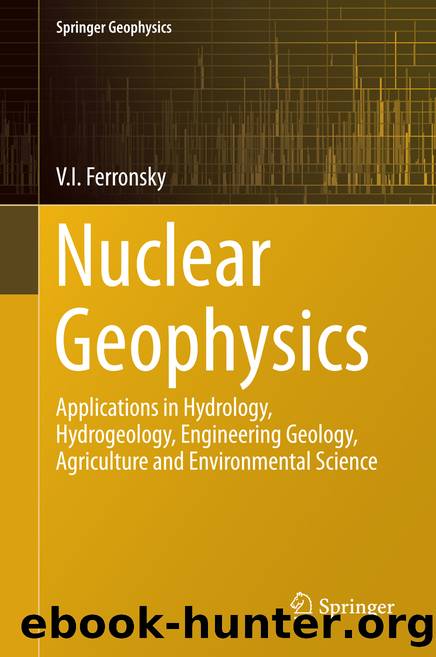Nuclear Geophysics by V.I. Ferronsky

Author:V.I. Ferronsky
Language: eng
Format: epub
Publisher: Springer International Publishing, Cham
3.Groundwater recharge in the past;
4.Identification of an area of groundwater recharge;
5.Relationship between aquifers;
6.Mixing proportions of groundwater of different genesis;
7.Groundwater residence time in an aquifer;
8.Relationship of waters in conjugate hydrologic basins.
More details about solving the above problems can be found in Ferronsky and Polyakov (2012).
9.7 Isotopic Composition of Formation Waters
It follows from the previous chapters that the processes of water evaporation and condensation are of great importance in the fractionation of isotopes of natural waters. At the same time evaporation is primarily an attribute of surface conditions. It might occur in shallow underground waters but it is generally agreed by hydrogeologists that groundwater evaporation does not occur on a regional scale (Zaitsev 1967; Smirnov 1971).
But in local zones underground evaporation is likely to take place. An example of such a phenomenon is the evaporation of groundwater accompanying oil and gaseous deposits (Sultanov 1961). As a rule, these processes of water evaporation occur at elevated temperatures (~â80â°C). In this case the isotopic fractionation factor s are αDâ=â1.032 and . The vapour phase differs insignificantly in isotopic composition from layer waters to a deposit. The water vapour that has been formed migrates with oil gases. During the migration of the vapour-gaseous mixture through porous layers at lower temperatures, underground fresh water deposits with mineralisation less than 1 g/l and δD and δ18O values greater than those that are characteristic of meteoric waters might form.
Thus, in the region of the Dnieper-Donets depression at depths exceeding 2000 m, waters with mineralisation of up to 4 g/l and values of δD from ââ21 to ââ53ââ° and 18O from ââ2.5 to ââ4.6ââ° were found. In this region, for oil waters with mineralisation ranging from 150 to 330 g/l the deuterium and oxygen-18 content varies within the limits δD from ââ21 to ââ54ââ° and 18O fromâ+â2.0 to ââ4.6ââ° (Yakubovsky et al. (1978).
Analogous waters were also found in the eastern part of the Terek-Sundzha oil and gas region at a depth of 4â5.5 км (Nikanorov et al. 1980). But naturally underground evaporation cannot result in considerable changes of the isotopic composition of the layer waters since the amount of evaporated water is always negligible in comparison with the amount of native water.
The basic process determining the isotopic composition of water undergoing underground circulation is that of isotopic exchange in the water ârock system. The isotopic exchange of water with gases (H2S, H2, CH4, CO2) and liquid hydrocarbons of oil also takes place. But these processes are considerably less effective than the exchange processes with water-bearing rocks. For example, according to Soyfer et al. (1967), the change in the isotopic composition of hydrogen in groundwaters due to exchange reactions with gaseous hydrogen and hydrogen sulphide is negligible.
The absence of the influence of isotopic exchange in the H2OâH2S system upon the isotopic composition of formation waters was demonstrated by Clayton et al. (1966) and Hitchon and Friedman (1969) By indirect means the possible scale of changes of hydrogen isotopic composition in groundwater due to exchange processes with liquid hydrocarbons of the oil series can be estimated.
Download
This site does not store any files on its server. We only index and link to content provided by other sites. Please contact the content providers to delete copyright contents if any and email us, we'll remove relevant links or contents immediately.
Whiskies Galore by Ian Buxton(41716)
Introduction to Aircraft Design (Cambridge Aerospace Series) by John P. Fielding(33014)
Small Unmanned Fixed-wing Aircraft Design by Andrew J. Keane Andras Sobester James P. Scanlan & András Sóbester & James P. Scanlan(32683)
Craft Beer for the Homebrewer by Michael Agnew(18079)
Turbulence by E. J. Noyes(7891)
The Complete Stick Figure Physics Tutorials by Allen Sarah(7262)
Kaplan MCAT General Chemistry Review by Kaplan(6819)
The Thirst by Nesbo Jo(6752)
Bad Blood by John Carreyrou(6472)
Modelling of Convective Heat and Mass Transfer in Rotating Flows by Igor V. Shevchuk(6352)
Learning SQL by Alan Beaulieu(6158)
Weapons of Math Destruction by Cathy O'Neil(6080)
Man-made Catastrophes and Risk Information Concealment by Dmitry Chernov & Didier Sornette(5875)
Digital Minimalism by Cal Newport;(5582)
Life 3.0: Being Human in the Age of Artificial Intelligence by Tegmark Max(5402)
iGen by Jean M. Twenge(5320)
Secrets of Antigravity Propulsion: Tesla, UFOs, and Classified Aerospace Technology by Ph.D. Paul A. Laviolette(5236)
Design of Trajectory Optimization Approach for Space Maneuver Vehicle Skip Entry Problems by Runqi Chai & Al Savvaris & Antonios Tsourdos & Senchun Chai(4955)
Electronic Devices & Circuits by Jacob Millman & Christos C. Halkias(4862)
